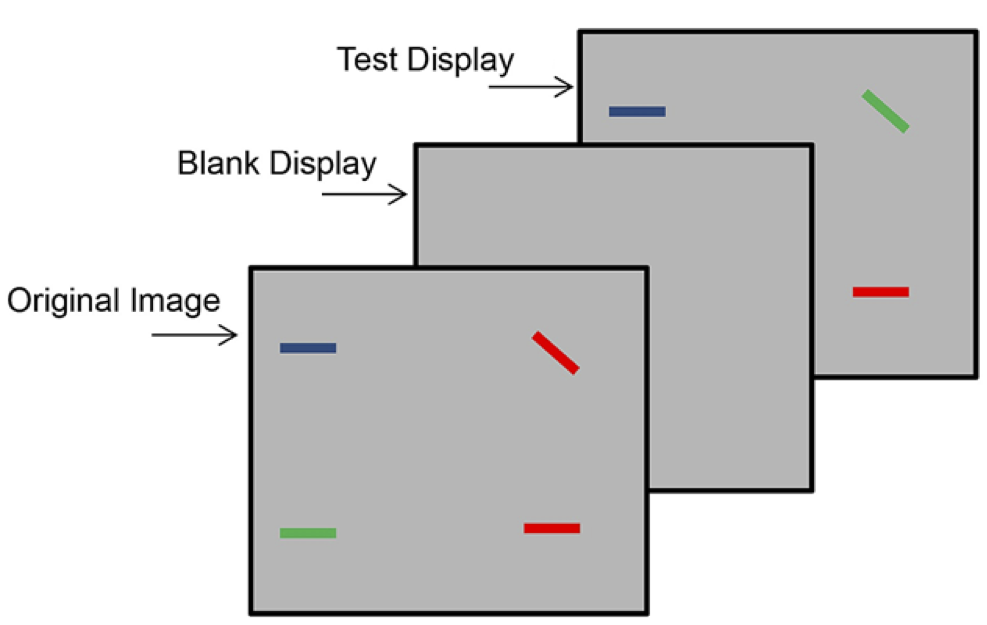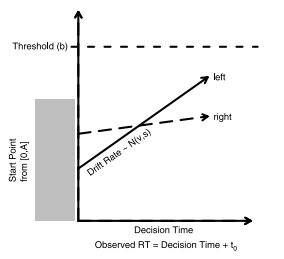visual short-term memory
verbal short-term memory
response time models
cognitive capacity
judgment and decision-making
absolute identification
visual search
What defines the capacity of visual working memory? There is debate over whether visual items are stored in an all-or-none fashion, or whether visual short-term memory is a more continuous and flexible resource. Evidence from change-detection tasks from our lab point towards a discrete style encoding of items. For example, we show this in (this paper) using response time models. A number of ongoing projects in our lab are looking more closely at the specific assumptions of the slots model (e.g., this paper).
top

I am also interested in how information is held and subsequently accessed and retrieved from short-term memory. Recent work suggests that the recognition of items in short-term memory might be based on a familiarity signal based on memory strenghts and the similarity between items in memory and a probe test item (our paper). In follow up work, we have shown that the strength of memories for letters and words decreases as a power function (our paper), and that there may be no need to posit separate short- and long-term memory stores for verbal memory.
top

Response time models are a set of computational models that are used to explain how people make relatively simple decisions. The models use parameters that represent psychological aspects of decision making. By fitting data with response time models and interpreting the resultant parameters, we can redescribe standard accuracy and response time data in terms of underlying cognitive processes. Researchers are working hard to increase the accessibility of these data analysis techniques (our own work here and here). We have also been working on extending these models for simple decisions out to more complex tasks, like visual search, short-term memory tasks, the go/no-go task, measuring cognitive capacity.
top

In an absolute identification task, participants are asked to recall the labels associated with stimuli that vary on only one dimension. Despite the apparent simplicity of the task, people's performance suggests a severe limit on human capacity for decision making. We have explored the conditions under which this limit can be improved (here). Absolute identification also reveals the human tendency to base responses on previous items and responses. We offer an explanation for such sequential effects here. In follow up work, we are looking at how this model can account for learning, as well as whether it generalizes to human classification and categorization when the stimuli vary on either one or multiple, separable, dimensions.
top

How are multiple streams of information processed? Is a limited resource distributed amongst those streams, like when you are trying to have two conversations at once. Sometimes, the two streams of information seem to combine to produce a larger signal. For example, when a warning signal is presented both visually and auditorily. Despite the simplicity of the question, it is remarkably difficult to answer. We have tried to answer such questions in some papers - e.g., here and here
top

People are faced with many complex decisions every day. For example, right now I must decide which example of a decision would be a good example of a decision for this website. How people make such decisions is an interesting area of research. In current work, we are attempting to combine our understanding of working memory processes and how people make decisions.
top

How people manage to find target objects in visual scenes is also a fascinating human ability. We have proposed a model for visual search that assumes people search through items one at a time, but that this is slow and serial search is aided by a parallel process that guides attention to items likely to be targets. This attention attraction can be disrupted by other aspects of the visual scene. For example, the sudden onset of items in the display tends to attract attraction. In current work, we are looking at how multiple calls for attention compete and/or cooperate with each other.
top
